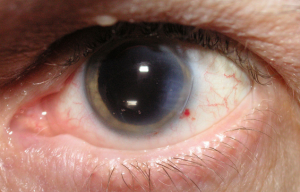Has your vision become blurry or foggy? You may have cataracts.
Cataracts are not uncommon. According to the National Eye Institute more than 20 million Americans have cataracts. The risk of developing cataracts increases every ten years starting at age 40. The good news is, cataracts are, in most cases, removable via routine procedures thanks to advances in eye treatments and surgery.
Let’s take a closer look at the symptoms, diagnosis process, and treatment of this common eye ailment.
What are the symptoms of cataracts?
Cataracts don’t typically form overnight, and most people don’t notice them until they start blocking out light, creating glare, or adding a yellow tinge to everything they see.

Here’s a quick overview of the most frequently reported cataract symptoms:
- Cloudy, milky, foggy, or blurry vision
- Changes to how you perceive color
- Double vision
- Difficulty driving at night, especially with glare from headlights, streetlights, and other light sources
- Issues with eyeglasses or contact lenses not working as they should
How do I know if I have cataracts?
While you might be experiencing some or all of the symptoms listed above, it’s essential to seek the professional opinion of a qualified and experienced eye doctor. Your doctor will look at your eyes and perform one or several specialized examinations, including:
- An eye chart exam. You’ve likely done an eye chart exam before in which your doctor asks you to read a series of numbers and letters, one eye at a time. Cataract exams are similar, except you may also undergo a glare test where light is shined in your eye.
- A slit-lamp exam. Using a microscope fitted with a bright light, your doctor will scrutinize different areas of your eye, including your cornea, iris, and lens.
- A retinal exam. Your doctor will administer eye drops that widen your pupils. This enables them to investigate the retina at the back of your eye and the cataract in greater detail.
How are cataracts treated?
Cataracts can only be treated with surgery. But, before you shudder in horror at the thought of having your eye operated on, don’t panic. Eye surgeries are extremely routine, and, at Luna Vision and Med Spa, we use a leading-edge, no-stitch method.
Even better, your cataract treatment can be combined with surgery that improves your vision. That means you can toss your pesky glasses and contact lenses for good.
What can I expect from cataract surgery?
Your doctor may use several types of surgery to treat cataracts in your eye. Whichever he or she chooses, the technique is more or less the same: your clouded lens is removed and replaced with a clear artificial one.
Before the procedure, your doctor will use local anesthesia to numb the eye area. You will remain awake throughout the surgery, which typically takes less than one hour from start-to-finish. You won’t need to stay overnight.
If you have cataracts in both of your eyes, your doctor may operate on one and wait for it to heal before treating the other.
How long does recovery take after cataract surgery?
After your procedure, you may be asked to stay in the doctor’s office for about an hour. You will be monitored for any adverse side effects, though these are rare.
After a few days, you’ll begin to notice your vision improving. In a week or two, you can resume your regular, day-to-day activities.
Ready to restore your vision?
Dr Dutt is a Board-Certified member of the American Academy of Ophthalmology, the American Society of Cataract and Refractive Surgeons, and the Pittsburgh Ophthalmological Society. She has completed over 5,000 cataract procedures, restoring vision to thousands of grateful patients.
If you suspect cataracts are impacting your eyesight, reach out today to schedule an appointment with Dr Dutt, an eye doctor in Greensburg, PA to discuss your needs.

0 Comments